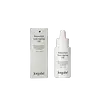What's inside
What's inside
 Key Ingredients
Key Ingredients

 Benefits
Benefits

 Concerns
Concerns

No concerns
 Ingredients Side-by-side
Ingredients Side-by-side

Vitis Vinifera Seed Oil
EmollientCoco-Caprylate/Caprate
EmollientC15-19 Alkane
SolventSimmondsia Chinensis Seed Oil
EmollientAscorbyl Tetraisopalmitate
AntioxidantBakuchiol
AntimicrobialPersea Gratissima Oil
Skin ConditioningHaematococcus Pluvialis Extract
AntioxidantUbiquinone
AntioxidantRosa Canina Seed Oil
EmollientRibes Nigrum Seed Oil
EmollientOenothera Biennis Oil
EmollientCarthamus Tinctorius Seed Oil
MaskingRosmarinus Officinalis Leaf Extract
AntimicrobialTocopherol
AntioxidantVitis Vinifera Seed Oil, Coco-Caprylate/Caprate, C15-19 Alkane, Simmondsia Chinensis Seed Oil, Ascorbyl Tetraisopalmitate, Bakuchiol, Persea Gratissima Oil, Haematococcus Pluvialis Extract, Ubiquinone, Rosa Canina Seed Oil, Ribes Nigrum Seed Oil, Oenothera Biennis Oil, Carthamus Tinctorius Seed Oil, Rosmarinus Officinalis Leaf Extract, Tocopherol
Vitis Vinifera Seed Oil
EmollientOrbignya Oleifera Seed Oil
EmollientSimmondsia Chinensis Seed Oil
EmollientArgania Spinosa Kernel Oil
EmollientCorylus Avellana Seed Oil
EmollientHelianthus Annuus Seed Oil
EmollientVaccinium Macrocarpon Seed Oil
Skin ConditioningHippophae Rhamnoides Fruit Extract
Skin ConditioningPunica Granatum Seed Extract
Skin ConditioningPongamia Glabra Seed Oil
Skin ConditioningTocopheryl Acetate
AntioxidantBisabolol
MaskingAesculus Hippocastanum Seed Extract
Skin ConditioningGlycyrrhiza Glabra Root Extract
BleachingChamomilla Recutita Flower Extract
MaskingDaucus Carota Sativa Root Extract
Skin ConditioningLecithin
EmollientGlycerin
HumectantWater
Skin ConditioningHydrolyzed Rice Protein
Skin ConditioningLithothamnion Calcareum Extract
Skin ConditioningPentylene Glycol
Skin ConditioningRosmarinus Officinalis Leaf Extract
AntimicrobialAlanyl Glutamine
HumectantArginine
MaskingBetula Alba Oil
MaskingOligopeptide-177
Oligopeptide-6
Skin ConditioningPotassium Sorbate
PreservativeSodium Hydroxide
BufferingTocopherol
AntioxidantVitis Vinifera Seed Oil, Orbignya Oleifera Seed Oil, Simmondsia Chinensis Seed Oil, Argania Spinosa Kernel Oil, Corylus Avellana Seed Oil, Helianthus Annuus Seed Oil, Vaccinium Macrocarpon Seed Oil, Hippophae Rhamnoides Fruit Extract, Punica Granatum Seed Extract, Pongamia Glabra Seed Oil, Tocopheryl Acetate, Bisabolol, Aesculus Hippocastanum Seed Extract, Glycyrrhiza Glabra Root Extract, Chamomilla Recutita Flower Extract, Daucus Carota Sativa Root Extract, Lecithin, Glycerin, Water, Hydrolyzed Rice Protein, Lithothamnion Calcareum Extract, Pentylene Glycol, Rosmarinus Officinalis Leaf Extract, Alanyl Glutamine, Arginine, Betula Alba Oil, Oligopeptide-177, Oligopeptide-6, Potassium Sorbate, Sodium Hydroxide, Tocopherol
 Reviews
Reviews

Ingredients Explained
These ingredients are found in both products.
Ingredients higher up in an ingredient list are typically present in a larger amount.
Rosmarinus Officinalis Leaf Extract comes from rosemary. Rosemary is native to the Mediterranean.
While Rosmarinus Officinalis Leaf Oil can be volatile due to its fragrant properties, the fragrance components are usually removed in the leaf extract.
Rosemary Leaf Extract contains many antioxidants such as rosmarinic acid and caffeic acid. Rosemarinic acid, a compound found in rosemary leaf, has been found to help soothe skin conditions such as eczema and acne.
Learn more about Rosmarinus Officinalis Leaf ExtractThis oil comes from the seeds of the desert shrub called Jojoba. It is more commonly known as jojoba oil, a non-comedogenic oil.
Jojoba oil does not contain fragrance and has many fatty-acids, making it a great soothing ingredient.
It also contains Vitamin E, a great moisturizing ingredient. Vitamin E is also an antioxidant and protects your skin against oxidative damage.
This ingredient humectant properties, meaning it helps draw moisture from the air. This helps keep your skin hydrated.
While jojoba has antibacterial properties, it is only able to kill some strains of bacteria.
Studies also show it helps in wound healing. In fact, Indigenous cultures have used jojoba as a moisturizer and to help treat burns for centuries.
Fun fact: Jojoba oil similar to natural human skin sebum, so it has a great effect on dry skin. It is also promising with helping to regulate sebum production.
Due to its fatty acid content, Jojoba oil may not be fungal acne safe. We recommend speaking with a professional if you have any concerns.
Learn more about Simmondsia Chinensis Seed OilTocopherol (also known as Vitamin E) is a common antioxidant used to help protect the skin from free-radicals and strengthen the skin barrier. It's also fat soluble - this means our skin is great at absorbing it.
Vitamin E also helps keep your natural skin lipids healthy. Your lipid skin barrier naturally consists of lipids, ceramides, and fatty acids. Vitamin E offers extra protection for your skin’s lipid barrier, keeping your skin healthy and nourished.
Another benefit is a bit of UV protection. Vitamin E helps reduce the damage caused by UVB rays. (It should not replace your sunscreen). Combining it with Vitamin C can decrease sunburned cells and hyperpigmentation after UV exposure.
You might have noticed Vitamin E + C often paired together. This is because it is great at stabilizing Vitamin C. Using the two together helps increase the effectiveness of both ingredients.
There are often claims that Vitamin E can reduce/prevent scarring, but these claims haven't been confirmed by scientific research.
Learn more about TocopherolVitis Vinifera Seed Oil comes from the grape vine. Grape seeds are a byproduct of creating grape juice or wine.
The components of grape seeds have many skin benefits. Research has found it to be antimicrobial and anti-inflammatory. It also contains many potent antioxidants such as Vitamin E , Vitamin C, proanthocyanidins, polyphenols, flavonoids, and anthocyanins. Proanthocyanidin has been shown to help even out skin tone.
Antioxidants help fight free-radical molecules. Free-radical molecules are capable of damaging our cells and other genetic material. Antioxidants help stabilize free-radicals by donating extra electrons. Grape seed extract may help reduce the signs of aging.
The antimicrobial properties of grape seed may help treat acne. However, more research is needed to support this claim.
Grape seed has also been found to help absorb UV rays. Grape seed extract should not replace your sunscreen.
The fatty acids of grape seed oil give it emollient properties. Emollients help soothe and soften your skin by creating a film. This film traps moisture within, keeping your skin hydrated.
Learn more about Vitis Vinifera Seed Oil